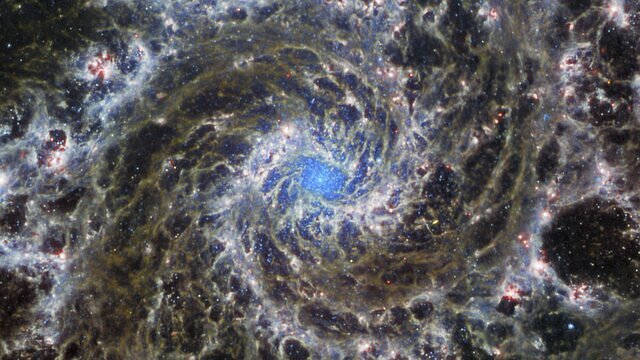Electromagnetic spectrum
The electromagnetic spectrum is a range of wavelengths of electromagnetic radiation. From long to short wavelength, the EM spectrum includes radio waves, microwaves, infrared, visible light, ultraviolet, x-rays and gamma rays.
Energy is propagated through space in the form of electromagnetic (EM) waves, which are composed of oscillating electric and magnetic fields. EM waves do not require a substance (like air or water) to travel through, meaning that — unlike sound — they can travel through empty space. In a vacuum, all EM waves travel at the same speed: the speed of light (which is itself an EM wave). Like all waves, an EM wave is characterised by its wavelength, and the range of wavelengths we observe, from very long to very short, is what we refer to as the EM spectrum. We divide up the EM spectrum roughly according to how the waves behave when they interact with matter and each division has a name. So we have: radio waves, which have the longest wavelengths; microwaves; infrared; visible light; ultraviolet; x-rays; and finally gamma rays, which have the shortest wavelengths. Celestial objects such as stars, planets and galaxies all emit EM waves at various wavelengths and so different telescopes are designed to be sensitive to different parts of the EM spectrum. EM radiation in and around the visible part of the spectrum is often referred to broadly as ‘light’, with shorter wavelengths referred to as ‘bluer’ and longer wavelengths referred to as ‘redder’.
By combining observations at different wavelengths, we can develop a more complete picture of the structure, composition and behaviour of an object than visible wavelengths alone can show. This makes Webb especially important, alongside existing telescopes such as the NASA/ESA Hubble Space Telescope. Webb's sensitive instruments provide excellent coverage of near- and mid-infrared wavelengths, enabling high-quality research into celestial objects that emit this kind of light, and providing critical extra details about targets also being studied at longer and shorter wavelengths.
The eighteen hexagonal mirrors that together make up Webb's primary mirror are coated in a thin layer of gold. This gives the telescope a distinctive look, but more importantly it's perfect for reflecting the infrared wavelengths to which Webb's instruments are sensitive. Webb has four instruments which all work in the infrared range: MIRI, which detects mid-infrared light, and NIRSpec, NIRCam and NIRISS, which are all sensitive to near-infrared light.
Even before cooperating with other telescopes, MIRI and NIRCam are frequently used together to obtain a more complete picture of a target over the whole of Webb's wavelength range. This image of the Pillars of Creation shows the different details which are highlighted in the different wavelength ranges — stars, particularly newly-formed stars, show up in near-infrared, while dust is placed on display by MIRI.



